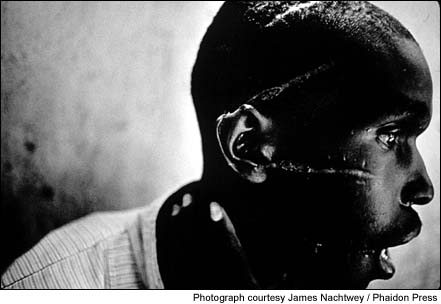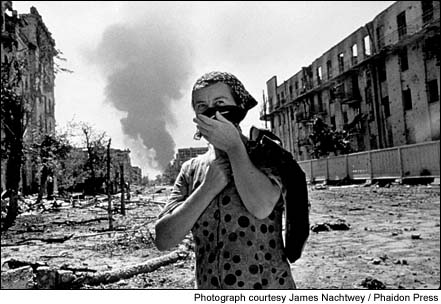|
(An appreciation of James Nachtwey's Inferno) by David Friend Last month a man left a tombstone on my doorstep. The slab was more than a foot long, nearly a foot wide, and as thick as a corpse's forearm. It arrived in a big brown box, as if someone had sent a stereo amp or some neatly packaged antique. When I opened the box, I saw the slab, black as a shroud, all nine-and-a-half mournful pounds of it. It was inscribed: INFERNO, in faint red letters. And then, below the title: JAMES NACHTWEY, in ominous black. It was the UPS man who had brought the box, shipped from one of those warehouses operated by Amazon.com. And the slab now rests on my coffee table, against my better judgment.
Nothing about this book is meant to be easy, according to its author, James Nachtwey, 52, arguably the most influential war photographer of his time. "If I can upset people, if I can ruin their day," Nachtwey recently told the Washington Post, "then I have done my job." The book is cumbersome to lift, difficult to hold or balance. Its form suits the gravity of its images: a Romanian child, abandoned and howling in a back-ward crib; the outstretched palm of a Somali woman who sits curled and starving in a wheelbarrow; death's lone eye glaring from the womb of a blanket's folds. The book, published this spring by Phaidon, traces war's toll on civilians in nine countries from Bosnia to Zaire. All of its 382 photographs were made during the bleak decade just passed. Over the last several years, thousands of photo books have been spun from humming presses, often in Italy and Japan. Some of these books brim with images of inhumanity in times of war. But rarely has one had as immediate and considerable an impact. Unlike many compendia of conflict, Inferno has been widely reviewed in newspapers and magazines, discussed on television and over the Internet. At book signings, Nachtwey has drawn crowds; under the glare of studio lights, he has stared down Charlie Rose and Oprah Winfrey. When a book this unwelcoming becomes a fitting subject for "Oprah," it is clear that something potent and new has been let loose upon the culture. Part of the reason for Inferno's success has been its audacity: 480 pages in length, the heft of a Rand McNally atlas, a sobering $125 price tag. (Amazon, thankfully, is selling it at a discount, for $87.50.) In this era of conglomerates and blockbusters--and now, sumo-sized books--a certain class of reader seems to relish any volume with this much critical, and literal, mass. Inferno's appeal is also a function of its author's stature. Over the last two decades, no photojournalist concentrating on war has acquired a more vaunted reputation. Nachtwey's professional credits are daunting: hundreds of editorial assignments (chiefly for Time magazine), a previous watershed work (Deeds of War), scores of honors (among numerous prizes, he has been the recipient of five Robert Capa Awards, three ICP Infinity Awards for Photojournalism, and was named Magazine Photographer of the Year six times). Daunting, too, is his professional aura. Among many of his peers, Nachtwey is considered not only the consummate war photographer in the tradition of Capa and Burrows, but a colleague of unfailing grace and principle. What's more, some say, he appears to possess an invincibility, bordering on the mystical. He "enters a zone," says one journalist who has worked with him in Africa, confiding that Nachtwey, on occasion, seems to be shielded by a force-field when under fire, "a protective circle. He told me one night that this power scared him." Nachtwey has said as much himself, admitting he sometimes feels that a "guardian angel" guides his way.
Inferno's provocative format is another part of the draw. The book is divided into nine lengthy chapters (one per country) that Nachtwey calls "narrative and cinematic." They are meant to echo nothing less than Dante's Nine Circles of Hell. (Quotes from Dante Alighieri, in fact, open the book.) Each chapter is a sequence of spreads, cankerous and wordless, meticulously printed in a rich cloak of black and gray on pliant white. Each photograph is framed by a severe band of black. Together, the spreads constitute a series of horror-panels. Like woodcuts in some modern-day Book of the Dead, many are as solemn as medieval religious paintings. Yet heaven is nowhere present in them. If anything, they evoke the busy, peopled netherworlds of Bruegel and Bosch instead, as if the isolated corners of their canvases had been distilled to their sinister essence: Hades pure and uncut, in stark black and white. "It's a visualization of the kind of hell on earth that can be created by human beings for human beings," Nachtwey said in a recent interview with French television correspondent Laura Haim of Canal Plus. "I felt devastated and angry against the atrocities that created such cruelty." One glimpses Nietzsche in Nachtwey. One hears the whisper of the deranged Colonel Kurtz from Apocalypse Now, Francis Coppola's masterful Vietnam epic. Inferno pulls its readers into the jungle hut with Kurtz to hear him describe his twisted logic in finding something sublime in a pile of limbs (severed from children who had recently received polio shots): "They had come and hacked off every inoculated arm. There they were in a pile, a pile of little arms. . . .And I realized like I was shot. . .with a diamond bullet right through my forehead, and I thought, my God, the genius of that, the will to do that." Inferno bears the stench of such menace and virtually aches with the sorrow of the victims of such acts. Nachtwey's images of hell on earth demand observation, then outrage, then response. Documentary photographs, he says in Inferno's afterword, often engender "a constituency." And his job, he insists, "is to help reach a broad base of people who translate their feelings into an articulate stance, then through the mechanisms of political and humanitarian organizations, bring pressure to bear on the process of change." Like recent works by Gilles Peress (including Farewell to Bosnia and The Silence)--one of Nachtwey's compatriots at the esteemed Magnum photo agency--the photo book has become the favored symphonic form for photographers long accustomed to the relative economy of the magazine photo essay when covering conflict. Inferno, in essence, is the photo book as extended clarion-call. While some have criticized Nachtwey for
breathing too much graphic beauty into the situations he photographs, Inferno's
maker is doing no such thing. Yes, his pictures are tightly composed, even
poetic, as photography historian and essayist Luc Sante contends in the
book's introduction. ("Nachtwey's photographs," he writes, "are always
clean and striking compositions... because he is honest and clear in his
stance.") But Nachtwey isn't after poetry. Rather, he is creating a palatable
context for conveying human
One last reason for Inferno's success, perhaps, is that the time requires it. Since the fall of Communism, ours is a society turned numb to conflicts worlds away. Ours is an era when much of the West is otherwise engaged - caught up in the lure of progress, profit, appearance and diversion. Inferno is merely a world's conscience stirring. It forces its readers to confront the fact that much of the planet is still living under the tyranny of the gun, and at the mercy of the inhumane. For whatever reason, Inferno has touched a nerve. And this is encouraging at a time when many bemoan the diminishing power of the still photograph. Tombstones are carved to memorialize the dead. But sometimes they are meant to awaken the living. ["Testimony," a retrospective exhibition of Nachtwey's work--and a complement to Inferno--is now on view at New York's International Center of Photography, Uptown, at 94th and Fifth Avenue. The show runs until July 23.] David Friend is Vanity Fair's Editor of Creative Development. (He can be contacted at dfriend@vf.com) |

